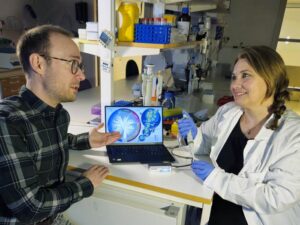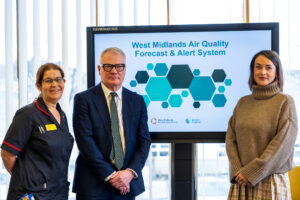During a five-month study, scientists from Surrey’s Global Centre for Clean Air Research (GCARE) worked with volunteers from Zero Carbon Guildford to create a new way of monitoring air quality in real-time.
Concentrating on how air quality can fluctuate in busy indoor spaces, the team installed low-cost sensors in the Zero Carbon Guildford building, a large public space in the town centre. The researchers then presented live air pollution data using a newly designed system, using emojis to represent the levels of pollution.
Air quality at indoor events is particularly unpredictable, with CO2 and PM10 generated by the people indoors, while PM2.5 enters from outside. Concentration levels of these pollutants can instantly change as the number of attendees increases and/or due to failure in the operation of ventilation systems, overcrowded indoor zones, frequent opening of doors/windows, and so on.
Professor Prashant Kumar, Director of the Global Centre for Clean Air Research at the University of Surrey, said: ‘We found that large gatherings can worsen the air quality indoors, and pollution outside can find its way in. But knowledge is power. Our study helped people find better ways to ventilate their homes and workplaces – improving air quality and improving their health.’
Ten Alphasense OPC_N3 PM sensors were distributed throughout the building and occupancy counters kept track of the number of people in it. Seven CO2 monitors were also installed to measure levels of the gas both horizontally and vertically
The team felt that developing a live air quality display system would be a powerful tool for raising the general public’s awareness about air pollution so they designed and developed a ‘Live Air Pollution Data’ (LAPD) tool to demonstrate air pollution data to the public in real-time. Two display screens showed the processed air pollution data to the public outside and ZCG visitors inside.
Professor Kumar: ‘Rather than study them from afar, we asked the local community what they wanted to know. We designed this research with them and helped them understand how to improve their air quality. We need more work like this. When scientists, public bodies and citizens come together, they can create a healthier environment for all.’
Members of the public then got tips on how to improve air quality through an interactive quiz.
The research concluded with the observation that: ‘Incorporating indoor air quality monitors with the support of communities to resolve local air quality problems can provide reliable exposure information and eventually benefit the public. This citizen science study proved that the collaborative approach towards raising awareness and improving individual knowledge about air pollution could reduce people’s exposure.’

















Leave a Reply